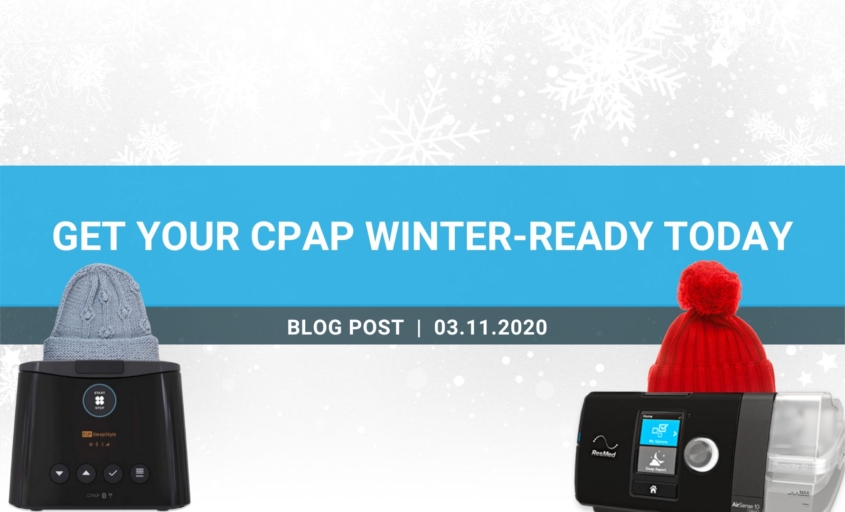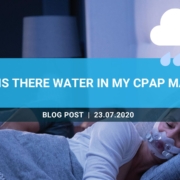Get your CPAP winter-ready today
Whether you love winter or the thought of snow gives you the shivers, the cold months will be here soon.
The coming weather means some extra preparations – car mechanics will start to remind you to get your snow tires on and have your engine checked (especially that battery!), you might be slogging leaves from your eaves or looking to find that snow shovel you stashed somewhere in the garage last spring.
- Believe it or not, there’s winterizing to do for your CPAP as well..
- Don’t get rained out
- Easy fixes
- Tube covers
- Keep it clean!
- Keep your equipment sanitary
- Put a stuffy nose in its place
- Don’t get left in the cold
- Conclusion
Believe it or not, there’s winterizing to do for your CPAP as well, but luckily Apnea Health can help!
Colder weather means cold and flu (and now Covid) season so extra sanitizing is in order, plus fluctuations in temperature can cause water condensation to happen in your tube (they call it rainout).
If you do get sick, nasal masks become hard or impossible to use, and depending where you live an increase in ice and harsh weather can make the household power supply iffy. Read on for some helpful tips on winterizing your CPAP…
Don’t get rained out
The main cause of rainout is the difference in the temperature of your room and the temperature in your tubing. The ResMed AirSense 10 AutoSet, Respironics DreamStation and F&P Sleep Style prevent rainout with their climate control functions:
Automated Climate Control: Adjusts the humidity level of your water chamber and the temperature of your heated hose to match your room’s climate
Heated Tubing: Controls the the moisture levels and the air temperature in your tube
Tube Drier: After using your CPAP, a snowflake symbol will flash and the machine will dry out any moisture that remains in your hose

There are easy fixes though
CPAP machines like the ResMed AirSense 10 AutoSet, the Respironics DreamStation and F&P SleepStyle all come with a heated tube which allows you to control the humidity. You may not even be aware that you have a heated hose or how to adjust it? No worries, we’ve prepared a video for you on how to fine tune the tube’s temperature.
Watch our video to learn more.
Tube covers
Another option is a tube cover – sort of the CPAP equivalent of fuzzy winter socks. Simple as can be, it’s an insulating wrap that goes on the hose to keep the temperature even and the condensation to a minimum.
Keep it clean!
While we’re on the subject of extra humidity, the moisture in your CPAP can become a prime environment for bacteria and viruses if you don’t watch your step.
If you want to stay ahead of the flu, one of the most important things you can do is make sure you’re getting enough restful sleep (you’re already doing that with your treatment – good for you!). That’s key for keeping your immune system working at its best.

The next thing you can do to help yourself is make sure you keep your equipment sanitary.
CPAP wipes used daily are an easy and quick way to keep your mask clean and germ-free. If you want to make extra sure you’ve rid your equipment of bacteria, viruses and mold, you may want to invest in a Lumin UV Sterilizer.
It uses ultraviolet light to destroy 99.9% of contaminants – now those are some odds we can live with! It takes hardly any effort and can do its job in about five minutes.
If you don’t have a Lumin, you can learn more about cleaning your gear the old-fashioned way by watching the video below:
Put a stuffy nose in its place
Some of us get colds more often than others – I usually count on coming down with something about once a winter. When it happens, congestion can make breathing through your nose all but impossible! Compact nasal or nasal pillow masks are light and unobtrusive, but when you have a stuffy nose, forget about it.
A full face mask, like the Vitera by Fisher & Paykel, gets you around the issue by allowing you to breathe through your mouth while continuing your nightly CPAP treatment. That way not only do you get to breathe comfortably, but you also continue to reap the benefits of CPAP treatment so you can get your rest and get better faster.
In fact, full face masks work so well when you’re congested that lots of patients choose to pick one up as a backup for when colds or allergies make their regular mask uncomfortable to use.

Don’t get left in the cold
Winter storms happen – falling tree branches take out power lines, ice and winds wreak havoc on towers, and in the case of a bad ice storm it could mean we’re stuck without power for hours or even days.
But there’s no reason for an interruption in power to interrupt your sleep! With a battery backup, you can plug your CPAP into the wall through the battery so it runs all night from regular AC power, then seamlessly kicks over to the battery if the power in the house goes out – you might not even wake up enough to notice.
Even if the power goes out longer term, a battery backup will keep your CPAP running for at least two nights, and if you’re really stuck in a winter apocalypse, there’s even an option to recharge using an automotive adapter.
There are CPAP batteries to power your machine through everything from a winter storm to a summer camping trip (or a camping trip in a winter storm, but if you do that you’re braver than I).
Conclusion
Just like with your car or your house, there are simple steps you can take to winterize your CPAP machine to make sure you get the most out of your therapy all year round. And as always, if you have any questions, we’re here to help!













